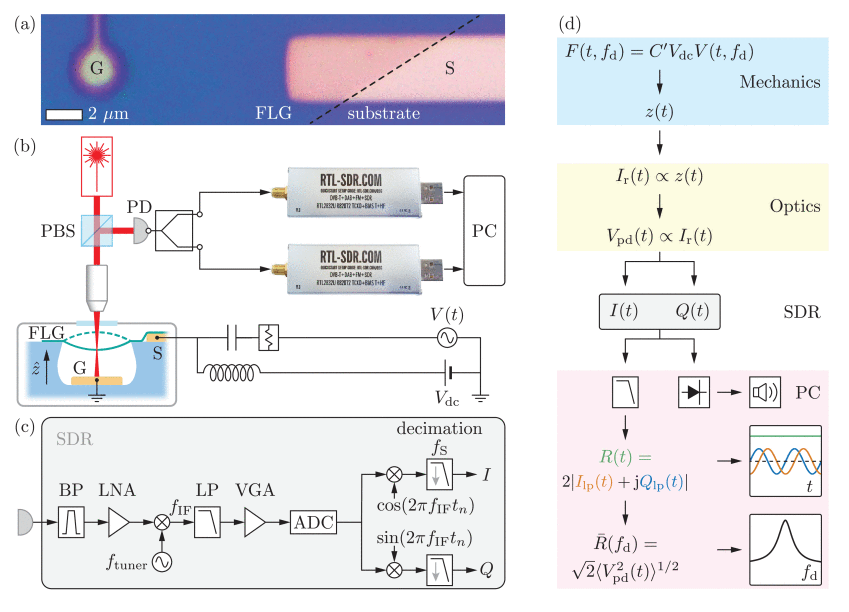Thank you to Joel Moser who has submitted news about his teams scientific research work at Soochow University in Suzhou, near Shanghai, China which makes use of RTL-SDR Blog V3 dongles in their research to replace bulky and expensive analysis equipment such as a lock-in amplifier, a vector network analyzer, or a spectrum analyzer. Their results show that an RTL-SDR can produce results as good as those more traditional pieces of equipment.
The researchers have also provided a summary video, which helps explain the science in an easier way. In a nutshell, as far as we understand it, they first use a laser optical interferometer to measure the graphene nanomechanical resonator, and then connect the output of the interferometer to the RTL-SDR, where the signal can be measured on a PC, and then easily put forward to further DSP processing in GNU Radio.
One interesting result is that they were able to recover very clear audio from the graphene nanomechanical resonator using the RTL-SDRs. This is highlighted in the video from around 4:25. Also provided via their website are two audio files demonstrating a clear reading of a Shakespeare sonnet, and a musical.
Our project is about detecting weak vibrations in nanomechanical resonators based on graphene drums. Graphene is an atomically thin membrane of carbon atoms. Graphene drums are made by suspending the membrane over an array of cavities nanofabricated in silicon oxide. Vibrations of the membrane are driven using a capacitive force at frequencies ranging from 10 to several hundreds of MHz. The detection of vibrations is done by optical interferometry, with the electrical output of our photodetector connected to a radio frequency measuring instrument. Usually, the measuring instrument is a lock-in amplifier, a vector network analyzer, or a spectrum analyzer, which are all rather bulky and expensive systems.
In our work, we demonstrate that graphene nanomechanical vibrations can be adequately measured with RTL-SDR v3 dongles. We find that the quality of our dongle-based measurements is as good as that of measurements made with a low noise spectrum analyzer, provided the driving force is not too small.
We take full advantage of your dongles by measuring the amplitude of two vibrational modes in parallel. For this, we split the output of the photodetector and connect it to two dongles. Measuring multiple modes in parallel is very valuable for nanomechanical sensing applications, as more information can be extracted compared to single mode measurements. However, this is a challenging task that requires several instruments collecting data in parallel. Here, we demonstrate that a composite of SDR dongles offers an alternative that is remarkably simple and inexpensive per frequency channel.
Finally, we show that our software-based instrument can be employed to demodulate human voice encoded in nanomechanical vibrations. For this, we drive vibrations with a frequency modulated force. As a baseband signal, we alternatively use a Chinese song performed by one of us, poetry by Shakespeare, and an excerpt from a musical.
We are now improving our measurement setup by synchronizing the clocks of several RTL-SDR v3 dongles to measure vibrational modes coherently. We are also greatly interested in employing your KrakenSDR for even better and cleaner multimode nanomechanical measurements.
A recent paper about our work can be freely accessed here:
Audio files for our demodulated nanomechanical signals can be found at the same address, but they are buried in a supplemental material (media) folder. Alternatively, the paper and the audio files can be found here:
Our work is very much inspired by recent scientific projects based on your dongles, many of which are cited in our paper.

